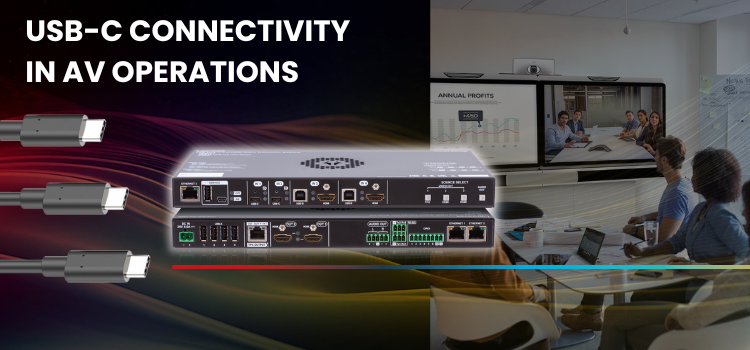USB-C Cables are Not Created Equal
Understand what to look for when deciding to purchase USB-C cables for connecting AV devices.

Sponsored Content
Today's meeting rooms and collaboration spaces are equipped with a wide range of devices including high-quality web cameras, microphones, speakers and dedicated room PCs to provide seamless meeting experiences.
Most high-quality meeting room peripherals have already adopted USB-C, and so did the vast majority of laptops and mobile devices. The wide adoption of USB-C in today’s consumer technology is creating a dramatic shift in AV applications and, because of the shift, USB-C will drastically change traditional meeting room connectivity.
The key advantage of USB-C is that it allows the transmission of 4K video, audio, USB data, and Ethernet as well as charging through a single connection, eliminating the need for additional cables by combining the functionality of four cables (including AV cables, USB cables, Ethernet cables and power cables) into one, effectively rendering legacy connections and designs obsolete.
This advantage translates into a wide range of benefits for both AV professionals and for those using USB-C enabled meeting spaces in their everyday work. For installers and integrators, it means offering simpler rooms with more versatile functionality at a better price point. For businesses, it means lower investment while also creating future-ready collaboration spaces. For end users, it delivers an enhanced meeting experience by simplifying how they connect to cameras and sound systems to share and present their content in the room. Using a single cable to transfer all those signals also allows easy host-switching, enabling users to hand over control of the room to other team members, creating more freedom in BYOD operations.
The USB Pyramid
By understanding one of the core concepts of USB technology, many issues can easily be avoided. USB devices connect to their host in a pyramid-like topology made of ‘tiers’, where the host (e.g. a BYOD laptop) is at the top at Tier 1 (or sometimes taking up Tier 2 as well, also known as Root Hub). USB networks are limited by latency, and every USB peripheral, hub or cable added to the chain takes up additional tiers and introduces latency. Based on the average latency the guideline is a maximum of seven tiers, and exceeding this can lead to connection issues.
Not every USB device is created equal, and depending on the class of the device it can add different levels of latency, determining the amount of tiers taken up in the USB ‘pyramid’.
A daily selection of features, industry news, and analysis for AV/IT professionals. Sign up below.
Lightware’s Full Featured 1m to 5m USB-C cables don’t add any additional tiers to a USB system, same for our 8m and 10m active optical cables (AOC) USB-C cables when transmitting USB 3.0. However, when AOC cables are transmitting USB 2.0 data, they add one additional tier to the system.
What’s in the Cable?
Another set of installation complications is rooted in an often overlooked yet crucial element of every USB-C application—the USB-C cable. If we said that not every USB device is created equal, then this is particularly true about USB-C cables.
It can be challenging to determine if a particular USB-C cable is suitable for a professional AV application simply by looking at it, given that the shape of the connector doesn’t reveal the features and the data speeds of the cable. It is therefore crucial that AV professionals choose the right cable for their applications that are ‘full-featured’ which allows them to bring the most out of USB-C technology and helps them avoid any operational issues, such as the lack of charging or insufficient video transmission.
To promote successful presentations and meetings, Lightware encourages system designers to clearly indicate to end users what USB-C features (USB host switching, AV, Ethernet, charging, etc.) are capable of with particular cables in meeting spaces.
Lightware Delivers
Recognizing the potential in USB-C connectivity as well as the associated challenges, Lightware has introduced the Taurus UCX product family, a versatile and powerful suite of devices designed to streamline connectivity and enhance user experience.
Lightware’s Taurus product line simplifies USB-C switching within collaborative environments, allowing users to walk into a room, connect their laptop or device, and use all available USB assets.
While the Taurus UCX was designed for standalone applications and thus, for smaller rooms, challenges arise when the distance between components exceeds standard cable lengths. Lightware tackled this issue by offering a portfolio of ‘Full Featured’ cables, including active optical cables up to 10 meters in length, and also developed the Taurus TPX, utilizing SDVoE technology to extend USB-C capabilities up to 100 meters in a point-to-point application.
Lightware has big plans for 2024 and beyond that look to the future needs of collaborative environments. Its vision of UC convergence with networked AV architectures manifested in the recently introduced Taurus TPN. The next generation of Taurus devices with SDVoE technology is Lightware’s newest development allowing AV professionals to create UC-over-IP applications with HDMI 2.0 signals and full bandwidth USB 2.0 from multiple sources to multiple destinations through 10G Ethernet networks.
Besides leading the way in USB-C signal management solutions, Lightware is dedicated to accelerating the adoption of USB-C connectivity in meeting rooms and offers comprehensive training and educational resources for AV professionals to help them overcome the initial challenges. Its mission is to help its partners and customers develop more versatile room systems, lower project costs, reduce programming labor, and accelerate deployments.
Click here to learn more about the cables and solutions discussed.

Lightware invents and delivers signal management solutions for the AV industry for more than 25 years, allowing AV and IT professionals to securely control, distribute, monitor and manage video and audio signals between diverse sources and multiple users. By utilizing USB, USB-C and HDMI connectivity their reliable and versatile extenders, matrix switchers and AV-over-IP devices empower meetings spaces, education applications and live events in more than 30 countries across 4 continents.
The staff of AV Technology serves the community of decision-makers comprising AV/IT technology managers and directors, instructional technologists, and anyone making or influencing AV/IT technology decisions within their respective facilities and institutions.
